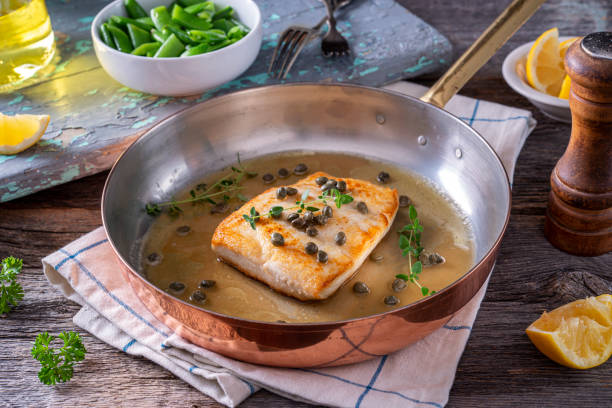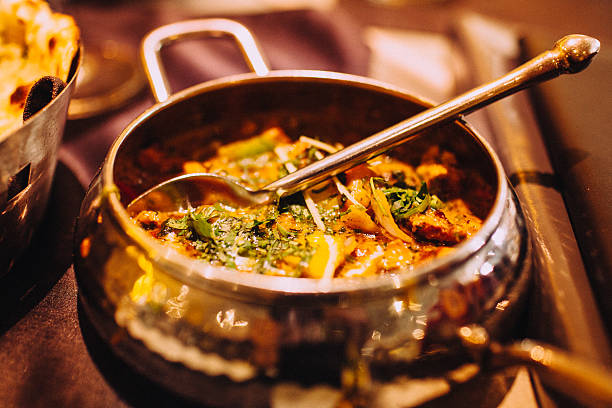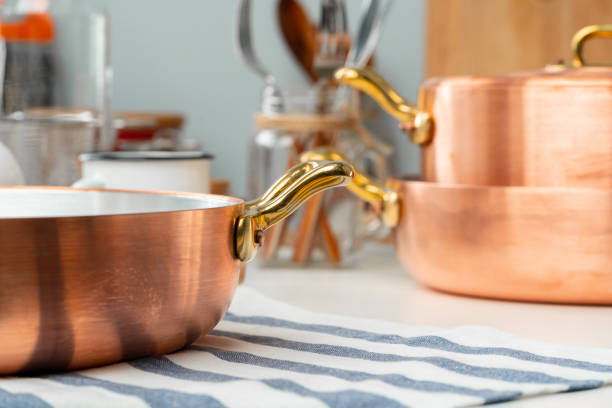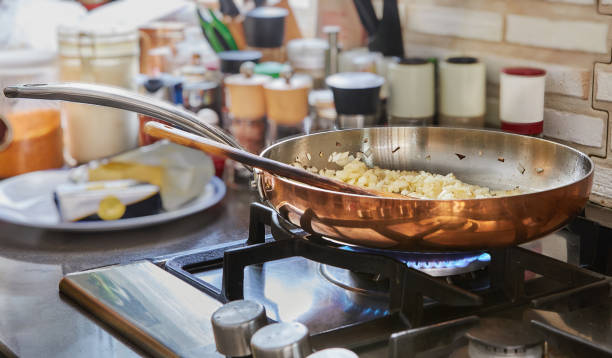In the sizzling world of culinary choices, where cookware options abound like a bustling marketplace, one metal stands out as the unsung hero of the kitchen – copper.
As kitchen enthusiasts debate the merits of various pans, the allure of copper pans quietly beckons, promising a symphony of flavors and unparalleled precision. Are copper pans the culinary secret weapon we’ve been overlooking?
Join us on a journey through the shimmering landscape of cookware as we unravel the mystery behind whether copper pans truly reign supreme in the realm of culinary excellence. Prepare to discover if the kitchen’s hidden gem is not just a conductor of heat but also a conductor of gastronomic magic!

Are Copper Pans Better for Cooking
Copper pans offer exceptional culinary benefits, making them a preferred choice for many chefs and cooking enthusiasts. Their superior heat conductivity, precise temperature control, and aesthetic appeal contribute to a unique cooking experience.
Unparalleled Heat Conductivity: A Culinary Symphony
Copper pans are celebrated for their unmatched heat conductivity. This means that they respond quickly to temperature changes, allowing for precise control during cooking. The even distribution of heat prevents hot spots, ensuring that your food cooks uniformly, a feature often praised by professional chefs.
Precision in Temperature Control: Crafting Culinary Masterpieces
One distinctive characteristic of copper pans is their ability to provide precise temperature control. This precision allows cooks to execute delicate techniques, such as sautéing and simmering, with accuracy. The responsiveness of copper pans to adjustments in heat settings empowers chefs to create culinary masterpieces with finesse.
Aesthetics Meets Functionality: The Allure of Copper Cookware
Beyond their culinary prowess, copper pans add a touch of elegance to any kitchen. The gleaming, reddish-brown surface develops a unique patina over time, enhancing its visual appeal. Many kitchen aficionados appreciate not only the functionality but also the aesthetic charm copper pans bring to their cooking spaces.
Copper and Cuisine: Navigating the Myths
While copper pans boast impressive attributes, it’s essential to address common myths, such as concerns about reactivity. Properly lined copper pans with stainless steel or tin negate any potential reactivity, ensuring safe and enjoyable cooking experiences. Understanding the nuances of copper cookware dispels misconceptions, allowing cooks to fully harness its benefits.
Advantages of Copper Pans
Copper cookware has gained popularity for its exceptional performance in the kitchen. Among its many advantages, superior heat conductivity stands out as a key factor influencing cooking precision and control.
Superior Heat Conductivity
1. Explanation of Copper’s Excellent Thermal Conductivity
Copper boasts remarkable thermal conductivity, making it an ideal material for cookware. Thermal conductivity refers to the ability of a material to transfer heat efficiently.
Copper excels in this aspect due to its atomic structure, allowing heat to rapidly move through the metal. This characteristic ensures that the entire surface of the copper pan heats up quickly and uniformly.
2. Impact on Cooking Precision and Control
The outstanding heat conductivity of copper pans translates to precise temperature control during cooking. When the pan is placed on the heat source, it rapidly adjusts to changes in temperature, allowing chefs to fine-tune the cooking process with agility.
This responsiveness is crucial for delicate dishes that require careful temperature management, enhancing the cook’s ability to execute recipes with finesse.
Even Heat Distribution
1. How Copper Pans Ensure Uniform Heat Across the Cooking Surface
Copper pans excel in promoting even heat distribution, a critical factor in achieving consistent cooking results. The molecular structure of copper allows it to conduct heat efficiently, ensuring that the entire surface of the pan receives an equal amount of heat.
This means that whether you’re searing, sautéing, or simmering, the entire cooking surface heats up uniformly, minimizing temperature variations.
2. Prevention of Hot Spots and Uneven Cooking
The exceptional conductivity of copper eliminates the formation of hot spots on the pan’s surface. Hot spots, areas that heat up more than others, can lead to uneven cooking and result in food sticking or burning in specific spots.
Copper’s ability to evenly distribute heat prevents such inconsistencies, ensuring that every part of the pan maintains a consistent temperature. This not only enhances the quality of the cooked food but also provides a more forgiving cooking experience.
Quick Responsiveness to Temperature Changes
1. Rapid Adjustment to Temperature Variations
One notable advantage of copper pans is their rapid responsiveness to changes in temperature. When exposed to a heat source, copper quickly absorbs and distributes heat throughout the pan.
Equally impressive is its ability to cool down swiftly when removed from the heat. This rapid adjustment ensures that chefs have precise control over the cooking process, allowing them to make instant modifications to achieve the desired results.
2. Benefits for Delicate Cooking Techniques
The quick responsiveness of copper pans is particularly beneficial for delicate cooking techniques. When preparing sensitive dishes that require precise temperature control, such as sauces, custards, or seafood, the ability of copper to respond swiftly to adjustments is invaluable.
This feature empowers chefs to navigate through temperature nuances with ease, preventing overcooking or undercooking and preserving the delicate flavors and textures of the ingredients.
Versatility in Cooking Styles
1. Copper Pans Suitable for Various Cooking Methods
Copper pans stand out for their exceptional versatility, accommodating a wide range of cooking methods. Whether you’re sautéing, frying, boiling, or simmering, copper pans offer reliable performance across diverse culinary techniques.
The even heat distribution and rapid responsiveness make them a versatile choice for both professional chefs and home cooks looking to explore different cooking styles.
2. Accommodation of High-Heat and Low-Heat Cooking
Another key aspect of the versatility of copper pans is their ability to handle both high-heat and low-heat cooking. Copper’s excellent heat conductivity allows for efficient heat transfer, making these pans suitable for high-temperature techniques like searing and caramelizing.
Simultaneously, the quick responsiveness ensures precise control over lower temperatures, making them suitable for gentle tasks such as melting chocolate or simmering delicate sauces.

Potential Drawbacks of Copper Pans
Reactivity with Certain Foods
1. Explanation of Copper’s Reactivity with Acidic Foods
While copper pans offer excellent heat conductivity, they can exhibit reactivity with certain acidic foods. Acidic ingredients, such as tomatoes or citrus fruits, can react with the copper, resulting in the release of copper ions into the food.
This reaction may impart a metallic taste to the dish and, over time, contribute to discoloration of the copper surface. It’s crucial to be mindful of the types of ingredients used in copper cookware to avoid unwanted reactions.
2. Potential Health Concerns and Mitigating Strategies
The release of copper ions into food raises potential health concerns, as excessive copper intake can be harmful. To mitigate this risk, it’s advisable to use copper pans lined with a layer of non-reactive material, such as stainless steel or tin.
This protective layer prevents direct contact between the food and the copper, minimizing the chances of reactivity. Regularly checking and replacing the lining, especially if signs of wear or damage are observed, further ensures a safer cooking experience.
Maintenance Challenges
1. Susceptibility to Tarnishing and Discoloration
Copper pans are susceptible to tarnishing and discoloration over time, mainly due to exposure to air and moisture. The natural oxidation process can lead to the formation of a patina on the surface of the copper, affecting its appearance. This tarnishing does not compromise the functionality of the pan but may impact its aesthetic appeal.
2. Tips for Proper Cleaning and Maintenance
To maintain the luster and performance of copper pans, regular cleaning and maintenance are essential. One effective method is to create a cleaning paste using equal parts salt, flour, and vinegar.
Gently apply this paste to the tarnished areas, allowing it to sit for a few minutes before rinsing and drying thoroughly. Alternatively, commercial copper cleaners are available, designed to remove tarnish and restore the pan’s shine.
It’s crucial to avoid abrasive scrubbers that can scratch the copper surface and compromise its integrity. Handwashing with mild dish soap and a soft sponge is recommended. Additionally, drying the pan immediately after washing helps prevent water spots and slows down the oxidation process.
Cost Considerations
1. Higher Initial Investment Compared to Other Cookware Materials
One notable consideration with copper pans is their higher initial cost compared to cookware made from materials like aluminum or stainless steel.
Copper, known for its exceptional heat conductivity and aesthetic appeal, tends to be priced at a premium. While this may present a financial barrier for some buyers, it’s essential to view the investment in copper pans as a long-term commitment to quality cooking.
2. Analysis of Long-Term Cost-Effectiveness
Despite the higher upfront investment, copper pans can prove to be cost-effective in the long run. The durability and longevity of copper cookware contribute to its value over time.
Unlike some other materials that may require replacement due to wear or loss of performance, well-maintained copper pans can last for generations.
Additionally, the superior heat conductivity of copper can result in more efficient cooking, potentially reducing energy consumption over time and providing additional cost savings.

Comparison with Other Cookware Materials
Stainless Steel
1. Heat Conductivity and Distribution in Stainless Steel
Stainless steel, a popular alternative to copper, has different heat conductivity properties. While it may not match the exceptional heat conductivity of copper, stainless steel is known for its even heat distribution.
The construction of stainless steel pans often includes aluminum or copper cores to enhance heat conduction. However, it generally takes a bit longer for stainless steel to reach and adjust to desired cooking temperatures compared to copper.
2. Durability and Maintenance Comparisons
In terms of durability, stainless steel is highly resilient and less prone to tarnishing or discoloration. Stainless steel pans are resistant to corrosion and rust, making them suitable for long-term use.
Maintenance is relatively straightforward as stainless steel is dishwasher-safe and can withstand more robust cleaning methods, including the use of abrasive scrubbers. Unlike copper, stainless steel does not require the same level of meticulous care to preserve its appearance.
Cast Iron
1. Heat Retention and Even Heating in Cast Iron
Cast iron cookware is renowned for its excellent heat retention and even heating capabilities. Once heated, cast iron retains heat for an extended period, allowing for consistent cooking temperatures.
This feature is particularly advantageous for slow-cooking and simmering dishes. While cast iron may take longer to heat up initially, its ability to distribute and maintain heat makes it a reliable choice for a variety of cooking techniques.
2. Weight and Seasoning Considerations
Cast iron pans are notably heavy compared to copper or stainless steel alternatives. While this weight provides stability and durability, it can be a factor for those who prefer lighter cookware.
Additionally, cast iron requires seasoning to develop a non-stick surface and prevent rusting. This involves coating the pan with oil and baking it to create a protective layer.
While this seasoning process contributes to the unique flavor profile of certain dishes, it requires regular maintenance to keep the pan in optimal condition.
Nonstick Coated Pans
1. Ease of Use and Cleaning in Nonstick Pans
Nonstick coated pans are widely appreciated for their user-friendly features. The nonstick surface facilitates easy food release, making cooking and cleaning a breeze. Minimal oil or fat is required during cooking, contributing to healthier meal preparation.
The nonstick coating reduces the likelihood of food sticking to the pan, simplifying both the cooking process and post-cooking cleanup. This makes nonstick pans particularly suitable for those who value convenience in the kitchen.
2. Limitations in Terms of High-Heat Cooking and Durability
While nonstick pans offer convenience, they have limitations, especially when it comes to high-heat cooking. The nonstick coating can deteriorate at high temperatures, releasing fumes and potentially compromising its nonstick properties.
Additionally, the durability of nonstick pans may be a concern, as the coating can wear off over time, requiring replacement. Careful use of utensils and avoiding abrasive cleaning tools are necessary to prolong the lifespan of nonstick pans.

Expert Opinions and Studies
Insights from Professional Chefs
1. Experiences with Copper Pans in Professional Kitchens
Professional chefs often favor copper pans for their superior heat conductivity and precise temperature control. The ability of copper pans to respond quickly to temperature changes aligns well with the demands of a fast-paced kitchen environment.
Chefs appreciate the even heat distribution, allowing for consistent cooking results across different recipes. The aesthetic appeal of copper cookware also adds a touch of sophistication to professional kitchens.
2. Recommendations and Tips
Experienced chefs often provide recommendations for maximizing the benefits of copper pans. They emphasize the importance of careful temperature management, leveraging the rapid responsiveness of copper for precise cooking.
Additionally, chefs recommend regular maintenance to prevent tarnishing, advising on gentle cleaning methods to preserve the pan’s appearance without compromising its functionality. Some chefs also suggest a combination of copper and other materials in cookware collections to benefit from the strengths of various materials.
Scientific Studies on Cookware Materials
1. Analysis of Heat Transfer and Cooking Efficiency
Scientific studies have extensively analyzed heat transfer and cooking efficiency in various cookware materials. Copper consistently ranks high in terms of heat conductivity, allowing for rapid and uniform heat distribution across the cooking surface.
Research has demonstrated that this property contributes to enhanced cooking precision and efficiency.
Studies often compare the thermal conductivity of materials like copper, aluminum, stainless steel, and cast iron, providing valuable insights for both professional chefs and home cooks seeking optimal cooking performance.
2. Health Implications of Various Cookware Materials
Scientific investigations have delved into the health implications of different cookware materials. For instance, studies have explored the potential release of metals into food, focusing on materials like copper and aluminum.
Copper, when unlined or improperly maintained, may release copper ions into acidic foods, raising health concerns associated with excessive copper intake.
Conversely, stainless steel and cast iron have been studied for their stability and minimal metal leaching, making them safer options for cookware. These findings contribute valuable information for consumers making choices based on health considerations.

FAQs
Why should I consider using copper pans for cooking?
Copper pans offer exceptional heat conductivity, ensuring even cooking and precise temperature control. This makes them an excellent choice for professional chefs and home cooks alike who value precision in their culinary endeavors.
What makes copper pans stand out in the kitchen?
Copper pans not only look stunning with their elegant design but also provide unmatched responsiveness to temperature changes. This means you can swiftly adjust cooking temperatures, giving you the flexibility needed to master a wide range of recipes effortlessly.
Are copper pans a healthier cooking option?
Yes, copper pans are a healthy choice for cooking as they require less oil or fat due to their excellent heat distribution. This can contribute to lighter and more nutritious meals without compromising on flavor.
How do copper pans enhance the flavor of dishes?
Copper pans react with certain foods, particularly acidic ingredients, creating a unique culinary experience. This reaction can enhance the flavors of your dishes, making copper pans a favorite among chefs who seek to elevate the taste of their creations.
Can copper pans save energy in the kitchen?
Absolutely! Copper pans heat up quickly and distribute heat efficiently, reducing the time it takes to cook your meals. This not only saves energy but also makes cooking a more time-efficient and enjoyable process.
Are copper pans suitable for all types of stovetops?
Yes, most copper pans are versatile and compatible with various stovetops, including gas, electric, and induction. This adaptability makes them a convenient and practical choice for a wide range of kitchen setups.
Do copper pans require special maintenance?
While copper pans may develop a natural patina over time, they are relatively easy to maintain. Regular cleaning with a mild solution can keep them looking pristine, and occasional polishing can restore their original shine, ensuring a long and beautiful lifespan.
Can I use copper pans in the oven?
Absolutely! Copper pans are oven-safe, allowing you to seamlessly transition from stovetop to oven. This versatility makes them ideal for a variety of cooking techniques and adds to their overall convenience in the kitchen.
Are copper pans a sustainable choice for cooking?
Yes, copper is a highly durable material, and quality copper pans can last for generations. Choosing long-lasting cookware reduces the need for frequent replacements, contributing to a more sustainable and eco-friendly kitchen.
Do copper pans require any specific utensils for cooking?
Copper pans are generally safe to use with most utensils, but to preserve their longevity, it’s advisable to avoid abrasive tools. Opt for wooden or silicone utensils to maintain the integrity of the pan’s surface and enjoy the benefits of cooking with copper for years to come.
Conclusion
In conclusion, copper pans offer a compelling array of advantages that make them a worthy choice for cooking enthusiasts. Their exceptional heat conductivity ensures precise temperature control, contributing to evenly cooked and flavorful dishes.
The responsiveness to changes in heat settings allows for immediate adjustments, giving cooks a level of precision that is often unmatched. Moreover, the aesthetic appeal of copper pans adds a touch of sophistication to any kitchen.
While they may require some maintenance to retain their luster, the overall benefits in terms of performance and aesthetic make copper pans a valuable investment for those who appreciate the art and science of cooking.
Ultimately, the choice of cookware is subjective and dependent on individual preferences, but the unique qualities of copper pans undeniably make them an appealing option for discerning chefs.
Other Articles You May Also Like:
- How To Clean Stove Drip Pans (8 Easy Ways)
- Best Oil For Seasoning Cast Iron (5 Pro Recommended)
- What Can You Cook In Stainless Steel Pans (5 Things You Should Know)
- What Not To Cook In Cast Iron Pan (6 Cool Things To Know)
- Why Do Restaurants Use Aluminum Pans (8 Helpful Reasons To Know)
- Is Stainless Steel Cookware Safe? (7 Cool Facts You Need To Know)
- Are Non Stick Pans Safe To Use (5 Cool Reasons)
- Do Copper Pans Scratch Easily (8 Cool Facts To Know)